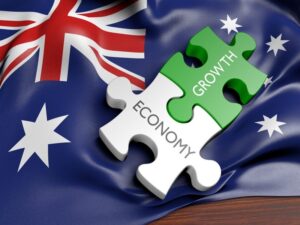With thanks to Van Eck, we have quoted some of their recent discussion on the outlook for Australia Shares and the Economy:
Recession bells are starting to toll as many central banks around the world aggressively increase policy rates in pursuit of containing multi-decade high inflation. However, the bells are not yet ringing in Australia as its outlook is more promising for several reasons, and these will likely mean we could avoid a recession.
Australian equities are looking like the go-to investment destination for 2023.
The wave of liquidity that flooded markets in 2020 in the wake of the COVID-19 crisis set new records. What followed was the most aggressive tightening cycle since the early 1980s, with 2022 heralding a new world order.
For the first time since 1994, both bond and equity markets were down.
Global markets were dragged down over the last year by the trifactor of multi-decade high inflation, the Russian invasion of Ukraine and China’s COVID-zero policy. Recession bells are starting to toll as central banks around the world aggressively increase policy rates in pursuit of containing multi-decade-high inflation. Russia’s invasion of Ukraine and corresponding Western sanctions have seen energy prices skyrocket, particularly in Europe, adding to investor angst.

While almost every major asset class took a sizeable hit in 2022, Australian equities presented a different story. Australian equities, as measured by the S&P/ASX 200, was one of the best-performing asset classes last year thanks to:
A. The Q4 resources rally.
The resources rally was off the back of China reopening optimism, which proved to be valid. Chinese President Xi Jinping has cited infrastructure spending (aka Australian resources) as the government’s main lever to rescue economic growth.
B. A higher ‘value’ exposure relative to other country equity benchmarks.
Put simply, a sizeable amount of companies listed in the S&P/ASX 200 looked pretty cheap in 2022, and the Australian market has a sizeable allocation to sectors that were undervalued, such as mining and those involved in energy production. In comparison, US equities (i.e., the S&P 500) were much more exposed to ‘growth’ stocks. These are companies that tend to be valued for their ability to make future profits, with many tech companies falling into this category. Growth stocks took a substantial hit last year as they don’t tend to look very enticing in a world in which interest rates are going up.
Five Reasons
We see this outperformance continuing for Australia in 2023, with the economic outlook better than other developed countries for five reasons and these will likely mean we could avoid a recession whereas other economies will not be so lucky.
1. Headline inflation
Australia has lower headline inflation (i.e., the total inflation in the economy) than the US and many European nations. This means the task of the RBA containing high inflation without triggering a recession, known as a ‘hard landing’, relative to other nations is not as difficult. The majority of Australian mortgages are variable which means cash rate increases immediately impact budgets and corresponding spending. This allows the RBA to pivot faster than other central banks based on changes in inflation.
2. Wage growth
Wage growth in Australia is less pronounced. This means the rise in the unemployment rate required to slow wage growth which is a cost inflationary pressure on business and ultimately the consumer, is lower compared to elsewhere in the world. The Australian government is increasing the number of permanent migration visas available in 2022-23 from 160,000 to 195,000 places. Net migration will help cool the tight labour market and lower wage cost pressures.
3. RBA pivot
The RBA is prioritising growth in 2023 over containing inflation between the 2-3% target. The RBA increased its Australian CPI forecast for 2023 from 2.75% to 4.75% over the past four quarters. In contrast, in the US, the Fed is resolute on driving down inflation to 2% despite the probability of a US recession increasing for 2023.
4. Major commodities exporter
Australia is one of the largest exporters of liquified natural gas (LNG), putting downward pressure on energy costs domestically. The Federal Government is implementing price caps on domestic coal and LNG supply, reducing energy inflationary pressures.
Governments also often turn to infrastructure spending as a fiscal measure to expand growth in an economic downturn. Chinese President Xi Jinping has cited infrastructure spending as its government’s main lever to rescue economic growth. The Australian resources sector could be a major beneficiary of this investment, as it was during the GFC.
5. Optimism abounds
Bond markets and the Organisation for Economic Co-operation and Development (OECD) are optimistic on Australia’s economic outlook relative to other G10 nations. The Australian government 10-year bond yield is higher than the 2-year whereas the US government bond yield curve is inverted. Yield inversion between the 2 and 10 year has historically been a leading indicator for an impending recession in the next 6 to 18 months. Australian projected real GDP growth for 2023 is expected to be one of the highest according to the OECD.
Conclusion
An Australian soft landing is likely.
Australia on balance, is much better positioned than most countries to manage economic challenges in 2023.
Wage growth has been relatively modest, and the return of migration over the next 12 months will likely ease the labour market tightness.
Australia also has abundant natural resources in short supply globally.
For 2023 we expect Australian equities to continue to outperform global equities. We favour Resources, REITs and Consumer Staples, are neutral on Banks and underweight Consumer Discretionary. During the year we expect to see improving relative performance from small cap and mid cap stocks.
We forecast the RBA cash rate to peak at 3.85% with the AUS 10yr yield to remain around the current 4% level, and we may see an inversion of the curve which could support bond proxies like REITs, infrastructure, and utilities.
The caveat to the above is a) if the US experiences a recession b) Australian housing market and c) an exogenous shock.


